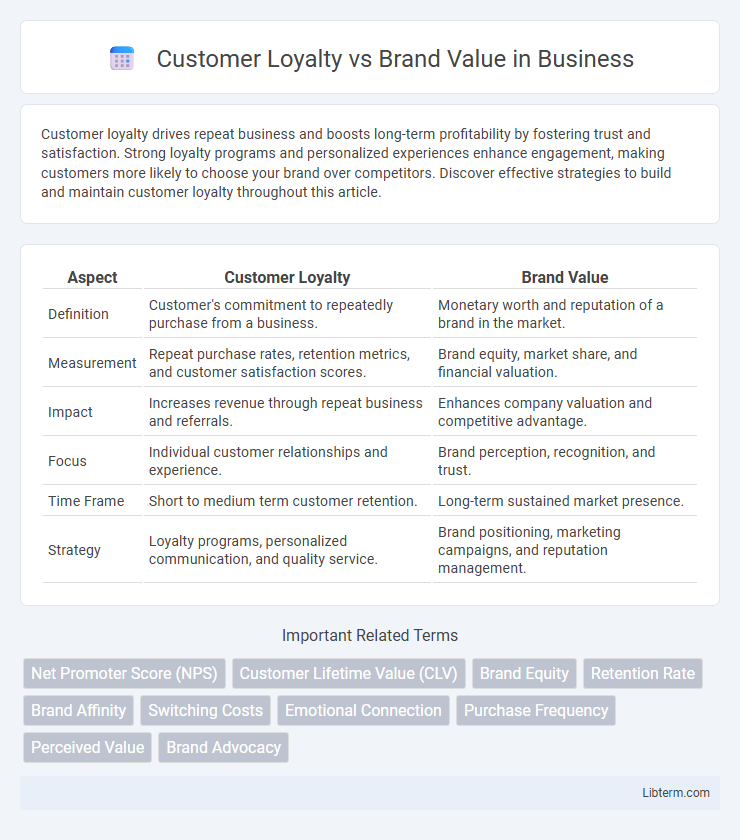Customer loyalty drives repeat business and boosts long-term profitability by fostering trust and satisfaction. Strong loyalty programs and personalized experiences enhance engagement, making customers more likely to choose your brand over competitors. Discover effective strategies to build and maintain customer loyalty throughout this article.
Table of Comparison
| Aspect | Customer Loyalty | Brand Value |
|---|---|---|
| Definition | Customer's commitment to repeatedly purchase from a business. | Monetary worth and reputation of a brand in the market. |
| Measurement | Repeat purchase rates, retention metrics, and customer satisfaction scores. | Brand equity, market share, and financial valuation. |
| Impact | Increases revenue through repeat business and referrals. | Enhances company valuation and competitive advantage. |
| Focus | Individual customer relationships and experience. | Brand perception, recognition, and trust. |
| Time Frame | Short to medium term customer retention. | Long-term sustained market presence. |
| Strategy | Loyalty programs, personalized communication, and quality service. | Brand positioning, marketing campaigns, and reputation management. |
Defining Customer Loyalty and Brand Value
Customer loyalty represents a customer's consistent preference for a brand based on satisfaction, trust, and repeat purchases, often measured through metrics like retention rates and Net Promoter Score (NPS). Brand value refers to the financial worth and market perception of a brand, derived from brand equity elements such as brand awareness, brand associations, and perceived quality. Understanding the distinction helps businesses tailor strategies to enhance long-term customer relationships and increase overall brand equity.
Key Differences Between Customer Loyalty and Brand Value
Customer loyalty reflects a customer's consistent preference and repeat purchase behavior towards a specific product or service, driven by satisfaction and trust. Brand value represents the overall worth of a brand based on customer perception, market position, and financial performance, influencing long-term brand equity. While customer loyalty directly impacts sales and retention rates, brand value encompasses broader attributes including reputation, emotional connection, and competitive advantage.
Why Customer Loyalty Matters for Businesses
Customer loyalty drives repeat purchases and increases customer lifetime value, which are crucial for sustaining business revenue. Loyal customers often provide valuable word-of-mouth marketing, reducing acquisition costs and strengthening brand reputation. High customer loyalty enhances brand value by creating a trusted relationship that differentiates a business in competitive markets.
The Role of Brand Value in Market Success
Brand value plays a crucial role in market success by driving customer loyalty and differentiating a company from competitors through perceived quality and emotional connection. Strong brand value increases customer trust and willingness to pay premium prices, directly impacting revenue growth and market share. Businesses with high brand value are better positioned to retain customers, attract new ones, and withstand competitive pressures.
Factors Influencing Customer Loyalty
Customer loyalty is primarily influenced by consistent product quality, personalized customer experiences, and effective communication strategies, which generate trust and emotional connections with the brand. Factors such as customer satisfaction, perceived value, and reward programs also play critical roles in fostering repeat purchases and long-term brand commitment. Strong customer loyalty enhances brand equity by increasing customer lifetime value, reducing churn rates, and promoting positive word-of-mouth referrals.
Elements That Drive Brand Value Growth
Customer loyalty significantly enhances brand value by fostering repeat purchases, positive word-of-mouth, and sustained revenue streams. Key elements driving brand value growth include consistent product quality, emotional connection, and trustworthiness, which deepen customer loyalty and differentiate the brand in competitive markets. Strong brand equity stems from customer satisfaction, perceived value, and effective engagement strategies that reinforce long-term relationships.
Measuring Customer Loyalty: Metrics and Methods
Measuring customer loyalty involves tracking key metrics such as Net Promoter Score (NPS), Customer Retention Rate (CRR), and Customer Lifetime Value (CLV), which provide quantitative insights into repeat purchase behavior and brand advocacy. Methods like customer surveys, transactional data analysis, and behavioral tracking help assess satisfaction levels and long-term engagement, reflecting the strength of loyalty. These metrics and methods together enable businesses to correlate customer loyalty with brand value, optimizing strategies for sustained growth.
Evaluating Brand Value: Tools and Techniques
Evaluating brand value involves tools such as brand equity measurement models, including Interbrand's Brand Valuation, which considers financial performance, brand strength, and customer loyalty metrics. Techniques like customer surveys, net promoter scores (NPS), and social media sentiment analysis provide quantitative and qualitative insights into brand perception and loyalty impact. These tools collectively help assess how customer loyalty translates into tangible brand equity, influencing long-term business value.
How Customer Loyalty Impacts Brand Value
Customer loyalty significantly enhances brand value by increasing repeat purchases and fostering positive word-of-mouth referrals, which lead to higher revenue stability and market share. Loyal customers also reduce marketing costs through organic brand promotion and increase lifetime customer value, contributing to stronger financial performance. Brands with high customer loyalty enjoy improved reputation and competitive advantage, directly elevating their overall brand equity in the marketplace.
Strategies to Enhance Both Customer Loyalty and Brand Value
Implement targeted loyalty programs that reward repeat customers with exclusive benefits, fostering long-term engagement and enhancing brand perception. Invest in consistent, high-quality customer experiences across all touchpoints to build trust and emotional connection, directly increasing both customer loyalty and brand value. Leverage data analytics to personalize marketing efforts, anticipate customer needs, and strengthen brand relevance in competitive markets.
Customer Loyalty Infographic

 libterm.com
libterm.com